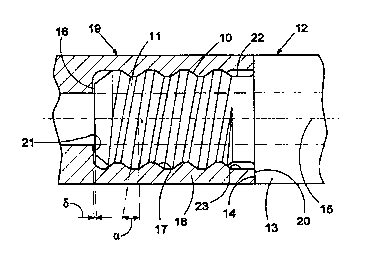Une partie des informations de ce site Web a été fournie par des sources externes. Le gouvernement du Canada n'assume aucune responsabilité concernant la précision, l'actualité ou la fiabilité des informations fournies par les sources externes. Les utilisateurs qui désirent employer cette information devraient consulter directement la source des informations. Le contenu fourni par les sources externes n'est pas assujetti aux exigences sur les langues officielles, la protection des renseignements personnels et l'accessibilité.
L'apparition de différences dans le texte et l'image des Revendications et de l'Abrégé dépend du moment auquel le document est publié. Les textes des Revendications et de l'Abrégé sont affichés :
| (12) Demande de brevet: | (11) CA 2192204 |
|---|---|
| (54) Titre français: | RACCORD FILETE |
| (54) Titre anglais: | THREAD COUPLING |
| Statut: | Réputée abandonnée et au-delà du délai pour le rétablissement - en attente de la réponse à l’avis de communication rejetée |
| (51) Classification internationale des brevets (CIB): |
|
|---|---|
| (72) Inventeurs : |
|
| (73) Titulaires : |
|
| (71) Demandeurs : |
|
| (74) Agent: | GOWLING WLG (CANADA) LLP |
| (74) Co-agent: | |
| (45) Délivré: | |
| (86) Date de dépôt PCT: | 1995-07-13 |
| (87) Mise à la disponibilité du public: | 1996-02-01 |
| Licence disponible: | S.O. |
| Cédé au domaine public: | S.O. |
| (25) Langue des documents déposés: | Anglais |
| Traité de coopération en matière de brevets (PCT): | Oui |
|---|---|
| (86) Numéro de la demande PCT: | PCT/SE1995/000852 |
| (87) Numéro de publication internationale PCT: | SE1995000852 |
| (85) Entrée nationale: | 1996-12-05 |
| (30) Données de priorité de la demande: | ||||||
|---|---|---|---|---|---|---|
|
Raccord fileté pour sondage à percussion comprenant au moins un filetage mâle (10) disposé sur un bout mâle (11) et un filetage femelle (17) situé à l'intérieur d'un manchon. Les filets sont cylindriques et comportent une surface extérieure de butée (20) à une extrémité libre du manchon, ainsi qu'une surface de contact (14) située sur le bout mâle. De plus, ils comportent une surface intérieure de butée (21) située dans le manchon et une surface terminale (16) à l'extrémité libre du bout mâle. Un jeu (.delta.) initial existe entre la surface terminale (16) du bout mâle et la surface intérieure de butée (21) du manchon, ce jeu étant éliminé après l'usure du raccord fileté. L'agrandissement de l'angle du pas (.alpha.) des filets (19, 17) permet de limiter le serrage du raccord, sous l'effet de la butée inférieure d'épaulement, tout en lui conservant une durée de vie acceptable.
Thread coupling for percussive drilling including at least one male thread (10), arranged on a spigot (11), and one female thread (17),
arranged within a sleeve. The threads are cylindrical and include an external stop surface (20) at a free end of the sleeve, and a contact
surface (14) on the spigot. Further, they include an internal stop surface (21) in the sleeve, and an end surface (16) on the free end of the
spigot. Initially, there is a play (.delta.) between the end surface (16) of the spigot and the internal stop surface (21) of the sleeve, this initial
play being eliminated after wearing-in of the thread coupling. By increasing the pitch angle (.alpha.) of the threads (19, 17), a less tightening
coupling is achieved, that due to the shoulder-bottom stop, still has an acceptable length of life.
Note : Les revendications sont présentées dans la langue officielle dans laquelle elles ont été soumises.
Note : Les descriptions sont présentées dans la langue officielle dans laquelle elles ont été soumises.

2024-08-01 : Dans le cadre de la transition vers les Brevets de nouvelle génération (BNG), la base de données sur les brevets canadiens (BDBC) contient désormais un Historique d'événement plus détaillé, qui reproduit le Journal des événements de notre nouvelle solution interne.
Veuillez noter que les événements débutant par « Inactive : » se réfèrent à des événements qui ne sont plus utilisés dans notre nouvelle solution interne.
Pour une meilleure compréhension de l'état de la demande ou brevet qui figure sur cette page, la rubrique Mise en garde , et les descriptions de Brevet , Historique d'événement , Taxes périodiques et Historique des paiements devraient être consultées.
| Description | Date |
|---|---|
| Le délai pour l'annulation est expiré | 1999-07-13 |
| Demande non rétablie avant l'échéance | 1999-07-13 |
| Réputée abandonnée - omission de répondre à un avis sur les taxes pour le maintien en état | 1998-07-13 |
| Demande publiée (accessible au public) | 1996-02-01 |
| Date d'abandonnement | Raison | Date de rétablissement |
|---|---|---|
| 1998-07-13 |
Le dernier paiement a été reçu le 1997-06-20
Avis : Si le paiement en totalité n'a pas été reçu au plus tard à la date indiquée, une taxe supplémentaire peut être imposée, soit une des taxes suivantes :
Les taxes sur les brevets sont ajustées au 1er janvier de chaque année. Les montants ci-dessus sont les montants actuels s'ils sont reçus au plus tard le 31 décembre de l'année en cours.
Veuillez vous référer à la page web des
taxes sur les brevets
de l'OPIC pour voir tous les montants actuels des taxes.
| Type de taxes | Anniversaire | Échéance | Date payée |
|---|---|---|---|
| TM (demande, 2e anniv.) - générale | 02 | 1997-07-14 | 1997-06-20 |
Les titulaires actuels et antérieures au dossier sont affichés en ordre alphabétique.
| Titulaires actuels au dossier |
|---|
| SANDVIK AB |
| Titulaires antérieures au dossier |
|---|
| KENNETH LARSSON |